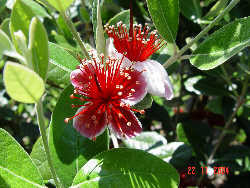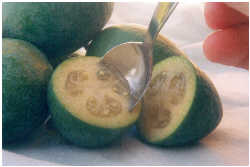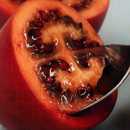Feijoa |
Acca sellowiana |
|
||
|
||
 |
||
 |
||
 |
||
The feijoa is from the Myrtaceae plant family and is native to Brazil and Uruguay. Feijoas can be considered as either warm climate or subtropical. First introduced into New Zealand in the early 1900's the fruit was small and it was not for another 20 years before new cultivars were imported that were larger with improved flavour.
Landscape Value
This versatile plant will screen out the neighbour or an unwanted view. Make sure you plant them where you can take full advantage of the stunning flowers over Christmas or the delicious fruit from autumn to early winter. Will grow well in a container for many years providing you provide plenty of moisture and feed.
Nutritional Value
The fruit has good levels of Vitamin C (50mg/100mg of flesh) and dietary fibre. One fruit will provide 23% of an adult's daily need.
How to Eat
The uses for Feijoas are numerous from simply eating fresh through to bottling the tasty bottle of wine. They can be added to fresh fruit salads cooked in puddings and are scrumptious in cakes. The fruit is not the only delicacy of this plant - the showy bright red flowers add life to salads or chocolate log.
Expected Yield
Year 3 plant approximately yield 2kg of fruit then doubling each year until 20 to 25kg of fruit.
Generic Fruiting Time
| J | F | M | A | M | J | J | A | S | O | N | D |
Growing
Sun
Prefers to grow in full sun light.
Wind
Feijoa trees have soft branches and in very exposed conditions will require protection from strong winds
Climate
Frost hardy and will handle temperatures down as low as -8 to -10
Soil
Will tolerate most soil conditions from heavy clay soils through to light sandy soils.
Fertiliser
Apply a general NPK fertiliser in early spring and again in summer
Pruning
Flowering occurs at the base of new seasons growth it is therefore important to prune early in the season (if pruning is required) to ensure growth happens for flowering to occur. Pruning is required to maintain the desired shape and stimulate to produce more flowering wood. It is also required to open the tree up so birds can have easier access for pollinating. Remove weak and damaged branches back to the main branch and thin the tree, if required, by removing internal branches back to the main trunk.
Pests
Feijoas are fairly Pest and Disease free. Leaf rollers, scale and thrips can attack feijoas and if sever attack occurs can be controlled with insecticides available through your local garden retailers. Sooty mould is a secondary attack after sap sucking insect have attacked the plant. The best way to cure the problem is by spraying for the insect attack. Soapy water will help shift the sooty mould if required.
Hardiness
During winter -10°C
Special Conditions


